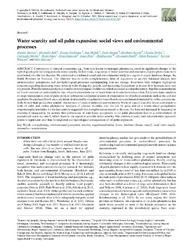Water scarcity and oil palm expansion: social views and environmental processes
Merten, Jennifer
Guillaume, Thomas
Tarigan, Suria
Agusta, Herdhata
Dislich, Claudia
Dittrich, Christoph
Faust, Heiko
Gunawan, Dodo
Hein, Jonas
Hendrayanto
Kuzyakov, Yakov
Hölscher, Dirk
21, 2: -
DOI: https://doi.org/10.5751/ES-08214-210205
Persistent URL: http://resolver.sub.uni-goettingen.de/purl?gldocs-11858/6698
Persistent URL: http://resolver.sub.uni-goettingen.de/purl?gldocs-11858/6698
Merten, Jennifer; Röll, Alexander; Guillaume, Thomas; Meijide, Ana; Tarigan, Suria; Agusta, Herdhata; Dislich, Claudia; Dittrich, Christoph; Faust, Heiko; Gunawan, Dodo; Hein, Jonas; Hendrayanto; Knohl, Alexander; Kuzyakov, Yakov; Wiegand, Kerstin; Hölscher, Dirk, 2016: Water scarcity and oil palm expansion: social views and environmental processes. In: Ecology and Society, Band 21, 2, DOI: 10.5751/ES-08214-210205.
 |
Dokument öffnen: |
Conversions of natural ecosystems, e.g., from rain forests to managed plantations, result in significant changes in the
hydrological cycle including periodic water scarcity. In Indonesia, large areas of forest were lost and extensive oil palm plantations were
established over the last decades. We conducted a combined social and environmental study in a region of recent land-use change, the
Jambi Province on Sumatra. The objective was to derive complementary lines of arguments to provide balanced insights into
environmental perceptions and eco-hydrological processes accompanying land-use change. Interviews with villagers highlighted
concerns regarding decreasing water levels in wells during dry periods and increasing fluctuations in stream flow between rainy and
dry periods. Periodic water scarcity was found to severely impact livelihoods, which increased social polarization. Sap flux measurements
on forest trees and oil palms indicate that oil palm plantations use as much water as forests for transpiration. Eddy covariance analyses
of evapotranspiration over oil palm point to substantial additional sources of evaporation in oil palm plantations such as the soil and
epiphytes. Stream base flow from a catchment dominated by oil palms was lower than from a catchment dominated by rubber plantations;
both showed high peaks after rainfall. An estimate of erosion indicated approximately 30 cm of topsoil loss after forest conversion to
both oil palm and rubber plantations. Analyses of climatic variables over the last 20 years and of a standardized precipitation
evapotranspiration index for the last century suggested that droughts are recurrent in the area, but have not increased in frequency or
intensity. Consequently, we assume that conversions of rain forest ecosystems to oil palm plantations lead to a redistribution of
precipitated water by runoff, which leads to the reported periodic water scarcity. Our combined social and environmental approach
points to significant and thus far neglected eco-hydrological consequences of oil palm expansion.

